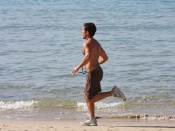Traditional strength and flexibility work targeting the hamstrings, quadriceps, and gluteals (back and front of the upper legs and hips) provides an important and immediately gratifying fitness routine. Of course MANY yoga poses address the wellness of your entire body/mind/breath; another reason not to back burner your your practice.
It is obvious that typical exercise routines often neglect the outer ‘seams’ of our legs and hips . Unfortunately the commonly experienced soreness or tenderness at the lateral (outside) knee is frequently a direct result of lack of toning and flexibility along the side of our body.

Let me introduce you to a little known lateral muscle called the tensor fascia latae (TFL), and the long band of tissue that the TFL is encased in: the Iliiotibial (IT) band. Here is a helpful image.
First, let’s locate your ASIS. The ASIS, commonly called the hip bones or points, are the bones that you can feel on either side of the front of the hip. Locate them by first manually locating your navel, and then simultaneously drawing your fingers downward at an angle almost to the outer line of your hip. You will run into your ASIS at this point.
Now, if you place the palm of your hand just at the outside and below your ASIS, you’ll discover the location of the TFL. Try doing this while lying down: cross your leg toward the midline of your body with your palm in place as described, and you will immediately feel a solid oval mound in your hand. There it is, the Tensor Fascia Lata!
Your TFL assists in internally rotating and abducting your leg (moving the leg away from the midline of the body).
IT Band and Iliotibial Band Syndrome (ITBS)
The IT band is actually a ribbon of fascial or connective tissue that begins at the hip right behind the ASIS, runs down the side of the thigh like a seam, and inserts on the outside of the knee cap as well as the large shin bone, and a hamstring muscle called biceps femoris.
If you are new to running, increased brisk exercise walking, and cycling, have increased your mileage in those activities, or have perhaps undertaken a new activity such as dancing or stair climbing, you may have experienced pain or burning on the outside of your knee. This could be a sign of ITBS. This discomfort is primarily caused by tension on the IT band which produces repetitive friction on the bony projection of the hip bone (femur). Additionally, weakness in the hip abductor muscles (like the tensor fascia lata) can also effect the tonality of the IT band, causing pain or clicking all the way down to the side of the knee.
If you are experiencing any of the knee pain, burning or clicking described above, it is important to refrain from the physical activity that might have been the trigger for the pain.In addition, icing the knee can provide relief.
A great outer leg stretch to address tightness in the side seams of the leg is demonstrated in the video below by Jill Miller, one of my most influential yoga teachers and mentors!
A version of this article originally appeared on YogaTuneUp.com.
